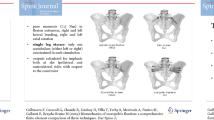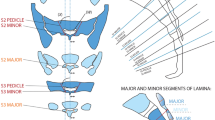Abstract
Purpose
To develop a modeling framework to predict the secondary consequences on spinal alignment following correction and to demonstrate the impact of pedicle subtraction osteotomy (PSO) location on sagittal alignment.
Methods
Six patients were included, and pelvic incidence (PI) was measured. Full-length standing radiographs were uploaded into PowerPoint and manipulated to model S1–S2 joint line sacral fractures at 15°, 20°, 25°, and 30°. PSO corrections with hinge points at the anterior superior corner and vertical midpoint of the L3-5 vertebral bodies were modeled. Anterior translation (AT) and vertical shortening (VS) were calculated for the six PSO locations in the four fracture angle (FA) models.
Results
PI had a strong effect in the mixed AT and VS models (P < 0.001). Both AT and VS were significantly different from zero at all FA (p < 0.001), and pairwise comparisons revealed all FA were different from each other with respect to both AT and VS after adjusting for PSO location (p < 0.001), increasing as FA increased. Varying PSO location resulted in significant differences in AT when comparing all locations (p < 0.001). AT was greatest for all FA in all patients when the PSO correction was performed at the L3-AS (p < 0.001). There were significant differences in VS when comparing the L5-Mid PSO location to the L3-AS, L3-Mid, L4-AS, and L4-Mid PSO locations (p < 0.034).
Conclusion
PSO correction superior to a sacral fracture resulted in AT and VS of the spine. It is crucial that these changes in spinal measures be predicted and accounted for to optimize patient sagittal alignment and outcomes.







Similar content being viewed by others
References
Rizkalla JM, Lines T, Nimmons S (2019) Classifications in brief: The Denis classification of sacral fractures. Clin Orthop Relat Res 477:2178–2181. https://doi.org/10.1097/CORR.0000000000000861
Kiapour A, Joukar A, Elgafy H, et al (2020) Biomechanics of the sacroiliac joint: anatomy, function, biomechanics, sexual dimorphism, and causes of pain. Int J Spine Surg 14:S3–S13. https://doi.org/10.14444/6077
Dussa CU, Soni BM (2004) A hidden injury. Emerg Med J 21:390–391. https://doi.org/10.1136/emj.2002.004176
Gibbons KJ, Soloniuk DS, Razack N (1990) Neurological injury and patterns of sacral fractures. J Neurosurg 72:889–893. https://doi.org/10.3171/jns.1990.72.6.0889
Rodrigues-Pinto R, Kurd MF, Schroeder GD et al (2017) Sacral fractures and associated injuries. Global Spine J 7:609–616. https://doi.org/10.1177/2192568217701097
Roy-Camille R, Saillant G, Gagna G, Mazel C (1985) Transverse fracture of the upper sacrum: suicidal jumper’s fracture. Spine 10:838–845
Sapkas GS, Mavrogenis AF, Papagelopoulos PJ (2008) Transverse sacral fractures with anterior displacement. Eur Spine J 17:342–347. https://doi.org/10.1007/s00586-007-0528-2
Pohlemann T, Gänsslen A, Tscherne H (1992) The problem of the sacrum fracture. Clinical analysis of 377 cases. Orthopade 21:400–412
Ha K-Y, Kim Y-H, Park H-Y et al (2021) Sacral insufficiency fracture after instrumented lumbosacral fusion: focusing pelvic deformation -a retrospective case series-. J Clin Neurosci 83:31–36. https://doi.org/10.1016/j.jocn.2020.11.034
Klineberg E, McHenry T, Bellabarba C et al (2008) Sacral insufficiency fractures caudal to instrumented posterior lumbosacral arthrodesis. Spine 33:1806–1811. https://doi.org/10.1097/BRS.0b013e31817b8f23
Schwab F, Patel A, Ungar B et al (2010) Adult spinal deformity—postoperative standing imbalance: how much can you tolerate? an overview of key parameters in assessing alignment and planning corrective surgery. Spine 35:2224–2231. https://doi.org/10.1097/BRS.0b013e3181ee6bd4
Le Huec JC, Thompson W, Mohsinaly Y et al (2019) Sagittal balance of the spine. Eur Spine J 28:1889–1905. https://doi.org/10.1007/s00586-019-06083-1
Savage JW, Patel AA (2014) Fixed sagittal plane imbalance. Global Spine J 4:287–296. https://doi.org/10.1055/s-0034-1394126
Hsieh PC, Ondra SL, Wienecke RJ et al (2007) A novel approach to sagittal balance restoration following iatrogenic sacral fracture and resulting sacral kyphotic deformity. J Neurosurg: Spine 6:5
Lu DC, Chou D (2007) Flatback syndrome. Neurosurg Clin N Am 18:289–294. https://doi.org/10.1016/j.nec.2007.01.007
Moe JH, Denis F (1977) The iatrogenic loss of lumbar lordosis. J Orthopaedic Translat 1:131
Vaccaro AR, Eck JC, Kepler CK, et al (2018) 10: Flatback syndrome: can lumbar Flatback syndrome be treated adequately with minimally invasive techniques? In: Controversies in Spine Surgery: MIS versus OPEN. Thieme Medical Publishers, Inc., Stuttgart, p b-003–125788
Gibbs WN, Doshi A (2019) Sacral fractures and sacroplasty. Neuroimag Clin N Am 29:515–527. https://doi.org/10.1016/j.nic.2019.07.003
Mehta S, Auerbach JD, Born CT, Chin KR (2006) Sacral fractures. JAAOS 14:656–665
Eastman JG, Shelton TJ, Routt MLC Jr, Adams MR (2021) Posterior pelvic ring bone density with implications for percutaneous screw fixation. Eur J Orthop Surg Traumatol 31(2):383–389. https://doi.org/10.1007/s00590-020-02782-4
Lu WW, Zheng Y, Holmes A, Zhu Q, Luk KD, Zhong S, Leong JC (2000) Bone mineral density variations along the lumbosacral spine. Clin Orthop Relat Res 378:255–263. https://doi.org/10.1097/00003086-200009000-00036
Radley JM, Hill BW, Nicolaou DA, Huebner SB, Napier KB, Salazar DH (2020) Bone density of first and second segments of normal and dysmorphic sacra. J Orthop Traumatol 21(1):6. https://doi.org/10.1186/s10195-020-00545-9
Safain MG, Burke SM, Riesenburger RI et al (2015) The effect of spinal osteotomies on spinal cord tension and dural buckling: a cadaveric study. J Neurosurg Spine 23:120–127. https://doi.org/10.3171/2014.11.SPINE14877
Buchowski JM, Bridwell KH, Lenke LG et al (2007) Neurologic complications of lumbar pedicle subtraction osteotomy: a 10-year assessment. Spine 32:2245–2252. https://doi.org/10.1097/BRS.0b013e31814b2d52
Kawahara N, Tomita K, Kobayashi T et al (2005) Influence of acute shortening on the spinal cord: an experimental study. Spine 30:613–620. https://doi.org/10.1097/01.brs.0000155407.87439.a2
Lee K-H, Kim K-T, Kim Y-C et al (2020) Radiographic findings for surgery-related complications after pedicle subtraction osteotomy for thoracolumbar kyphosis in 230 patients with ankylosing spondylitis. J Neurosurg Spine 33:366–372. https://doi.org/10.3171/2020.3.SPINE191355
Martin CT, Holton KJ, Elder BD et al (2022) Catastrophic acute failure of pelvic fixation in adult spinal deformity requiring revision surgery: a multicenter review of incidence, failure mechanisms, and risk factors. J Neurosurg Spine 38(1):98–106. https://doi.org/10.3171/2022.6.SPINE211559
Acknowledgements
We thank Paul Lender, BS for his assistance with statistical analysis.
Funding
The authors did not receive support from any organization for the submitted work.
Author information
Authors and Affiliations
Contributions
Cole J. Homer: Made substantial contributions to the conception and design of the work, and the acquisition, analysis, and interpretation of data. Revised the work critically for important intellectual content. Approved the version to be published and agree to be accountable for all aspects of the work in ensuring that questions related to the accuracy or integrity of any part of the work are appropriately investigated and resolved. Jason J. Haselhuhn: Made substantial contributions to the analysis and interpretation of data. Revised the work critically for important intellectual content. Approved the version to be published and agree to be accountable for all aspects of the work in ensuring that questions related to the accuracy or integrity of any part of the work are appropriately investigated and resolved. Arin M. Ellingson: Made substantial contributions to the conception and design of the work, and the acquisition, analysis, and interpretation of data. Revised the work critically for important intellectual content. Approved the version to be published and agree to be accountable for all aspects of the work in ensuring that questions related to the accuracy or integrity of any part of the work are appropriately investigated and resolved. Joan E. Bechtold: Made substantial contributions to the conception and design of the work, and the acquisition, analysis, and interpretation of data. Revised the work critically for important intellectual content. Approved the version to be published and agree to be accountable for all aspects of the work in ensuring that questions related to the accuracy or integrity of any part of the work are appropriately investigated and resolved. David W. Polly: Made substantial contributions to the conception and design of the work, and the acquisition, analysis, and interpretation of data. Revised the work critically for important intellectual content. Approved the version to be published and agree to be accountable for all aspects of the work in ensuring that questions related to the accuracy or integrity of any part of the work are appropriately investigated and resolved.
Corresponding authors
Ethics declarations
Conflict of interest
CH and JH declare no financial conflicts. AE declares institutional research support from Medtronic and the NIH. JB declares research support from the Department of Defense, DePuy Synthes, FocusStart, Medtronic, NIH (NIAID, NIAMS, NICHD), SI-Bone, and Zimmer Biomet; is an American Society of Biomechanics board/committee member; and is on an editorial/governing board, receives publishing royalties, and financial/material support from JBJS—American. DP declares consulting fees from Globus Medical and Alexion; institutional grant/research support from Medtronic and MizuhoOSI; consulting fees, royalties, and honoraria from SI-Bone; and royalties/other financial/material support from Springer.
Ethical approval/review
This study was approved by the University of Minnesota Institutional Review Board.
Additional information
Publisher's Note
Springer Nature remains neutral with regard to jurisdictional claims in published maps and institutional affiliations.
Rights and permissions
Springer Nature or its licensor (e.g. a society or other partner) holds exclusive rights to this article under a publishing agreement with the author(s) or other rightsholder(s); author self-archiving of the accepted manuscript version of this article is solely governed by the terms of such publishing agreement and applicable law.
About this article
Cite this article
Homer, C.J., Haselhuhn, J.J., Ellingson, A.M. et al. Development of a sacral fracture model to demonstrate effects on sagittal alignment. Spine Deform 11, 1325–1333 (2023). https://doi.org/10.1007/s43390-023-00721-x
Received:
Accepted:
Published:
Issue Date:
DOI: https://doi.org/10.1007/s43390-023-00721-x




